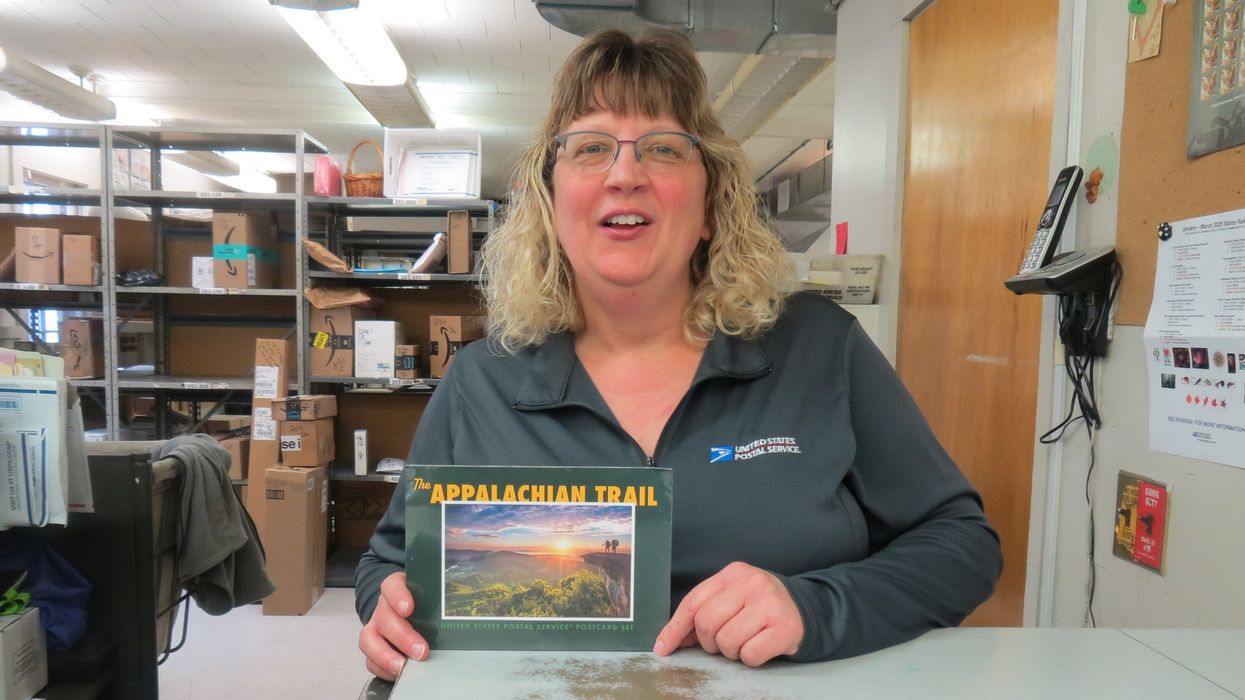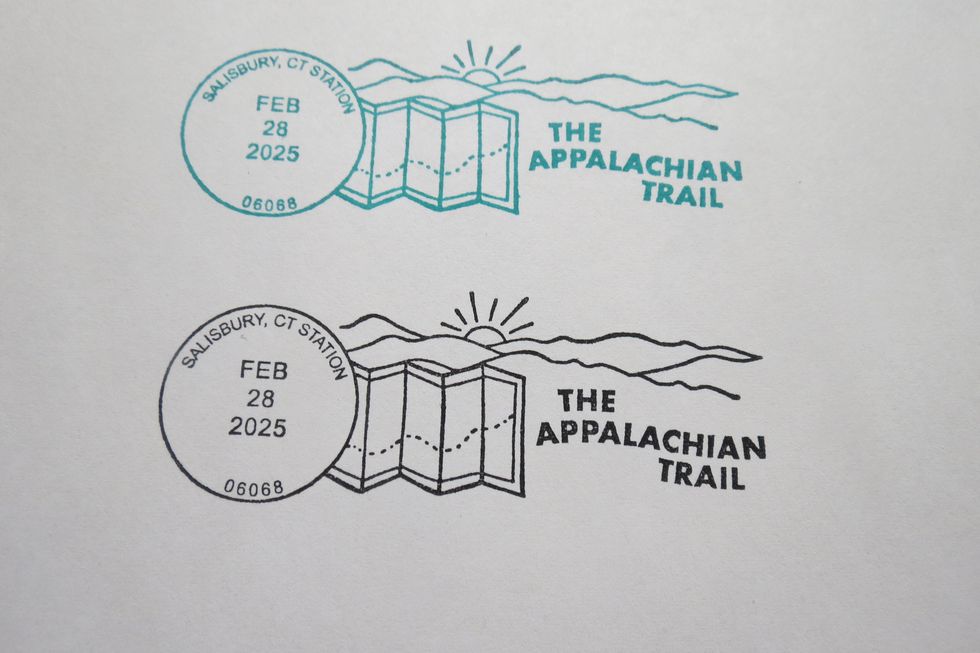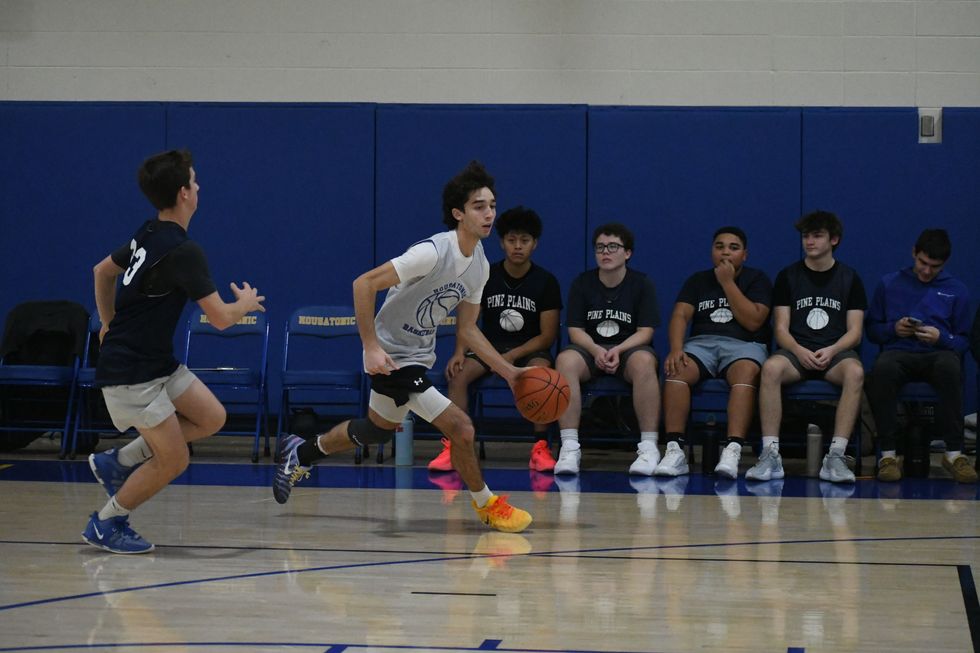Appalachian Trail stamps include scene from Kent

Lisa Hoage, postmistress of the Salisbury Post Office, shows a postcard set depicting the newly offered Appalachian Trail stamps including the one for Connecticut.
Ruth Epstein

Lisa Hoage, postmistress of the Salisbury Post Office, shows a postcard set depicting the newly offered Appalachian Trail stamps including the one for Connecticut.
KENT — The whole country now knows what residents of states along the Appalachian Trail have always known. The nearly 2,200-mile route that stretches from Springer Mountain, Georgia, to Katahdin, Maine, is said to offer peace, beauty and a respite from the stresses of modern-day life.
On Feb. 28, the U.S. Postal Service unveiled a pane of 15 forever stamps depicting images taken along the trail in each of the 14 states it traverses, plus one general scene, to commemorate its 100th anniversary.
The idea for the pathway was conceived in 1925 and built by private citizens. It was completed in 1937 and today is managed by the National Park Service, U.S. Forest Service, Appalachian Trail Conservancy, numerous state agencies and thousands of volunteers. According to its website, it is considered the world’s longest hiking-only trail, crossing through scenic, wooded, pastoral, wild and culturally resonant land along the Appalachian Mountains.
The site chosen for the Connecticut stamp is the Ned Anderson bridge over Ten Mile River. The river forms the border between Kent and Sherman, with the northern end of the span located in Kent.
Nestell K. “Ned” Anderson was a dairy farmer living in Sherman. While walking in the woods in 1929, he met Judge Arthur Perkins, who was active in the movement to build the Appalachian Trail. Perkins introduced him to Myron Avery, who was instrumental in the trail movement. Avery and Perkins gave Anderson the responsibility for creating the 70-mile route of the AT in Connecticut. He personally mapped and built much of the state’s trail, and for a time he was the sole maintainer. Anderson also organized the Housatonic Trail Club in 1932 to help maintain the trail.

Through trail hikers are an integral part of the culture in the Northwest Corner. Residents love to regale listeners about their experiences of meeting with, and sometimes befriending, those who come walking through the towns during spring and summer as they head to their destination.
Hikers also enjoy the amenities found in many of the towns. There is a shower at the Welcoming Center in Kent. Salisbury boasts two hostels that cater to hikers. Trail angels are known to set up meals at certain entry points to provide nourishment and conversation for those passing through.
For 45 years Richard Bramley, owner of the Cornwall Package Store, has been offering a free beer — or non-alcoholic beverage — to those who take a break from their hike while passing his shop on Route 7 in Cornwall Bridge.
“Anybody who does that hike deserves a free beer,” Bramley said. He also keeps a log, asking visitors to make a comment, which he enjoys reading even years after they’ve been by.
Post office personnel are very familiar with hikers who send packages of essentials ahead which are there for pick-up when they arrive. Salisbury Postmaster Lisa Hoage talked about the dozens of hikers she sees during the hiking season.
Since the stamps debuted, Hoage said there has been a lot of interest from those wishing to purchase them. She showed the many letters of request from around the country. There is also a special pictorial postmark for hand canceling in both black and green, for which she gets daily requests. There are also cards and magnets with the image available. Someone arrived on Feb. 28, saying he was traveling from North Adams, Massachusetts, to Kent to get each town’s postmark. They will be available until June 29.
Steve Barlow of Torrington has hiked parts of the Connecticut AT. During a recent excursion, he was enjoying the view looking down the Housatonic Valley from a high point in Sharon when he noticed a bird floating in the wind currents.
Barlow recalled, “At first, I thought it was a crow and then decided it was a hawk as it got closer. Then I finally realized it was a bald eagle. He glided right toward me before veering off into the trees to my right. That was pretty cool. The trail has such spectacular views.”

The Torrington Transfer Station, where the Northwest Resource Recovery Authority plans to expand operations using a $350,000 state grant.
TORRINGTON — The Northwest Resource Recovery Authority, a public entity formed this year to preserve municipal control over trash and recycling services in northwest Connecticut, has been awarded $350,000 in grant funds to develop and expand its operations.
The funding comes from the Department of Energy and Environmental Protection via its Sustainable Materials Management grant program. It is intended to help the NRRA establish operations at the Torrington Transfer Station as well as support regional education, transportation, hauler registration and partnerships with other authorities.
Founded by the City of Torrington in May 2025, the NRRA was established to oversee regional municipal solid waste management. Its creation followed a $3.25 million offer by USA Waste & Recycling to purchase the Torrington Transfer Station — a sale that would have privatized trash services in the region.
The proposed sale was initially approved by the MIRA Dissolution Authority, the entity responsible for dissolving the state’s former Materials Innovation and Recycling Authority, which owned the Transfer Station at the time. Before the transaction could close, the state intervened and directed that the facility’s operating permit be assigned to the NRRA to preserve a publicly controlled alternative.
MIRA has since dissolved, and the Transfer Station is currently operated by the state Department of Administrative Services. Many towns in northwest Connecticut have expressed interest in joining the NRRA. As of December, Torrington and Goshen were the only two municipalities in the authority.
At the Dec. 11 meeting of the Northwest Hills Council of Governments (COG) — a regional planning body representing 21 municipalities in northwest Connecticut — Director of Community and Economic Development Rista Malanca encouraged more towns to sign on.
“We need towns to join the Northwest Resource Recovery Authority to show your support, show this is what you want to do,” Malanca said.
Salisbury First Selectman Curtis Rand said his municipality is planning a town meeting in January to vote on a resolution to join the NRRA. Cornwall’s Board of Selectmen recently discussed scheduling a town meeting in the winter for the same purpose. Sharon, Falls Village and North Canaan have also expressed continued interest in pursuing a public option.
Kent is the northernmost member of the Housatonic Resource Recovery Authority, a regional solid waste authority representing 14 municipalities stretching south to Ridgefield. COG towns expressed interest in joining HRRA in 2024, but they were denied and set out to develop the NRRA.
“We also have been having conversations with the Capital Region Council of Governments and the Naugatuck Valley Council of Governments to think about how we can use existing resources, maybe some of these grant funds, to bring in shared resources or shared staffing that will help with some of the recycling coordinating efforts,” Malanca said.
With grant funds secured, NRRA aims to grow to a point that it can take over operations at Torrington Transfer Station to serve as a regional hauling hub. What happens to the trash after that has yet to be determined. Currently, it is being shipped to a landfill out of state. The existing municipal refuse hauling contracts that were established with the state expire in 2027.
The Salisbury Winter Sports Association (SWSA) will host its annual Junior Jump Camp, a two-day introduction to ski jumping, on Saturday and Sunday, Dec. 27 and 28, from 9 a.m. to 2 p.m. at Satre Hill in Salisbury.
The camp is open to children ages 7 and up and focuses on teaching the basics of ski jumping, with an emphasis on safety, balance and control, using SWSA’s smallest hill. No prior experience is required.
The cost is $50 per child and includes instruction and lunch on both days. For more information or to register, visit www.skireg.com/swsa-camp or email info@jumpfest.org
Jesse Bunce, first selectman of North Canaan.
LITCHFIELD — The Northwest Hills Council of Governments welcomed six newly elected municipal leaders Thursday, Dec. 11, at its first meeting following the 2025 municipal elections.
The council — a regional planning body representing 21 towns in northwest Connecticut — coordinates transportation, emergency planning, housing, economic development and other shared municipal services.
Barkhamsted First Selectman Meaghan Cook, Goshen First Selectman Seth Breakell, Kent First Selectman Eric Epstein, Norfolk First Selectman Henry Tirrell, North Canaan First Selectman Jesse Bunce and Torrington Mayor Molly Spino were each elected to their post in November.
They filled the seats of their predecessors on the COG, who were each given a toast of appreciation: Nick Lukiwsky (Barkhamsted), Todd Carusillo (Goshen), Marty Lindenmeyer (Kent), Matt Riiska (Norfolk), Brian Ohler (North Canaan) and Elinor Carbone (Torrington).
COG Executive Director Rob Phillips said the outgoing members were given a going away mug that read “You’re living the dream still.” Members voted to appoint Warren First Selectman Greg LaCava to fill a vacancy on the Council’s Executive Committee. COG members voted by paper ballot, and LaCava defeated Burlington First Selectman Doug Thompson for the vacant seat.
Ryan Segalla takes a fadeaway shot over a defender.
FALLS VILLAGE — Housatonic Valley Regional High School’s boys basketball team defeated Pine Plains High School 60-22 in a scrimmage Tuesday, Dec. 9. The non-league preseason game gave both sides an opportunity to run the court ahead of the 2025-26 varsity season.
HVRHS’s senior-heavy roster played with power and poise. The boys pulled ahead early and kept their foot on the gas through to the end.
By halftime the score was 33-8. Junior varsity players subbed in for the second half, but not before the starters got some in-game dunk practice. By the end Housatonic totaled 60 points to Pine Plains’ 22.

Nick Crodelle led the Mountaineers offensively with 13 points. Anthony Labbadia and Wyatt Bayer scored nine points each. Anthony Foley scored eight points. Owen Riemer and Ryan Segalla each scored seven points. Peyton Bushnell hit a three-pointer. Jaxon Visockis and Henry Berry each scored two points.
HVRHS begins Berkshire League competition on the road at Nonnewaug High School Tuesday, Dec. 16, with a 6 p.m. tip off.

